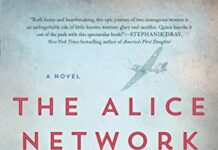
Ebook Info
- Published: 2017
- Number of pages: 368 pages
- Format: Epub
- File Size: 1.28 MB
- Authors: Jessica Shattuck
Description
Set at the end of World War II, in a crumbling Bavarian castle that once played host to all of German high society, a powerful and propulsive story of three widows whose lives and fates become intertwined—an affecting, shocking, and ultimately redemptive novel from the author of the New York Times Notable Book The Hazards of Good Breeding.
Amid the ashes of Nazi Germany’s defeat, Marianne von Lingenfels returns to the once-grand castle of her husband’s ancestors, an imposing stone fortress now fallen into ruin following years of war. The widow of a resister murdered in the failed July 20, 1944, plot to assassinate Adolf Hitler, Marianne plans to uphold the promise she made to her husband’s brave conspirators: to find and protect their wives, her fellow resistance widows.
First Marianne rescues six-year-old Martin, the son of her dearest childhood friend, from a Nazi reeducation home. Together, they make their way across the smoldering wreckage of their homeland to Berlin, where Martin’s mother, the beautiful and naive Benita, has fallen into the hands of occupying Red Army soldiers. Then she locates Ania, another resister’s wife, and her two boys, now refugees languishing in one of the many camps that house the millions displaced by the war.
As Marianne assembles this makeshift family from the ruins of her husband’s resistance movement, she is certain their shared pain and circumstances will hold them together. But she quickly discovers that the black-and-white, highly principled world of her privileged past has become infinitely more complicated, filled with secrets and dark passions that threaten to tear them apart. Eventually, all three women must come to terms with the choices that have defined their lives before, during, and after the war—each with their own unique share of challenges.
Written with the devastating emotional power of The Nightingale, Sarah’s Key, and The Light Between Oceans, Jessica Shattuck’s evocative and utterly enthralling novel offers a fresh perspective on one of the most tumultuous periods in history. Combining piercing social insight and vivid historical atmosphere, The Women in the Castle is a dramatic yet nuanced portrait of war and its repercussions that explores what it means to survive, love, and, ultimately, to forgive in the wake of unimaginable hardship.
User’s Reviews
Amazon.com Review An Amazon Best Book of April 2017: Much of the buzz touting Jessica Shattuck’s WWII novel, The Women in the Castle, likens it to Kristin Hannah’s wildly popular, The Nightingale. It’s an apt comparison—both feature brave women overcoming nearly unfathomable obstacles. But their association actually made me hesitant to pick it up. Surely the well of enthusiasm for Nazi-related dramas has to be running dry, and if it hasn’t, then an author really needs to “bring it.” Well, that well is still brimming as it turns out, and Ms. Shattuck certainly does. The women referred to in the title are widows of three conspirators involved in the assassination attempt on Hitler. Marianne von Lingenfels, whose moneyed pedigree has protected her from the more unsavory punishments of the war, has been tasked with locating the other resistance widows, and ensuring their safety. But she is no superhero. Along with the naïve Benita and inscrutable Ania, they represent the everyday, ordinary Germans swept up in the extraordinary, who survived as best they could when the right thing to do wasn’t always clear (or even an option). If you’re curious about what it was like to be a typical citizen during this time–if you struggle to comprehend how a society could become a breeding ground for Hitler’s brand of evil, The Women in the Castle offers some insight. It also draws some chilling parallels to things brewing in the political climate today. Jessica Shattuck has provided a worthy addition to the canon of great WWII literature, one that answers why the appetite for this genre has not abated: In many ways, we still haven’t learned the lessons that history has to teach us. –Erin Kodicek, The Amazon Book Review Review “If you love historical fiction, this is your must-read book: It’s captivating, fascinating, and incredibly faithful to the events as they happened, and Jessica Shattuck reveals an entirely new side of what it’s like to be a woman in wartime.” — Newsweek“Moving . . . Shattuck’s achievement―beyond unfolding a plot that surprises and devastates―is in her subtle exploration of what a moral righteousness looks like in the aftermath of the war, when communities and lives must be rebuilt, together.” — New York Times Book Review“A masterful epic.” — People Magazine“A poignant, World War II page-turner.” — Marie Claire“Offers a mesmerizing new look at the aftermath of the war . . . with insight and empathy, The Women in the Castle stands tall among the literature that reveals new truths about one of history’s most tragic eras.” — USA Today“If you’re a historical fiction fan, this will be your new favorite novel of 2017. It’s so emotionally powerful there’s a chance the literary-induced chills will stay with you well into summer.” — Redbook Magazine, 20 Books By Women You Must Read This Spring“Fans of The Nightingale and other classic World War II stories will fall in love with this compelling new perspective on women at war.” — Helen Simonson, New York Times bestselling author of The Summer Before the War and Major Pettigrew’s Last Stand“Riveting and emotional, The Women in the Castle is a WWII story like you’ve never seen before.” — Bustle“For your friend who loves a good war drama. About a woman who plays castle with other war widows across Germany post WWII.” — The Skimm“A virtuoso of time and place, Jessica Shattuck has created a heart-smashingly good story that will change the way you look at current events, and leave you asking, ‘What would I do if I were in these characters’ shoes?’ Powerful and prescient, an important book everyone should read.” — Jamie Ford, New York Times bestselling author of Hotel on the Corner of Bitter and Sweet and Songs of Willow Frost
Reviews from Amazon users, collected at the time the book is getting published on UniedVRG. It can be related to shiping or paper quality instead of the book content:
⭐ I bought this as a possibility for our book club – and heard the usual groans when I pulled it out and explained the premise. I’m known as being obsessed with WWII stories. This novel takes a very different look at that time period – from the experiences of those who were left behind in a divided Germany. Not only left behind, but in shame and guilt, as they were the wives of the men who tried to assassinate Hitler. Three very different women, with different backgrounds and experiences, all drawn together only because they were the wives of assassins who were executed.I couldn’t put the book down – read it in two days. Four stars because it is just a darn good read – a story well told from beginning to end. Comparing it to the Nightengale, there is less suspense and intrigue – and much more about the emotions of these women – the way they are treated, and how they look at themselves in the aftermath.It was chosen by the book club as the September read, as there is much to discuss after reading it. So little attention has been given to the Germans who were left behind to scratch out a life – perhaps they had no sympathy or support for Hitler – but they are treated, nonetheless, as the enemy by the Russian invaders – and more sympathetically by the Americans.It is interesting to find out how life turned out for them. The author obviously spent time on her research, as there is a ring of truth and realism in her writing. I’m looking forward to the discussion of the book in September – and highly recommend the novel – reading it is time well spent.
⭐ The Women in the Castle focuses on three women in post WWII Germany. These women are brought together by Marianne, the wife of one of the men executed for attempting to assassinate Hitler. She had promised that if the plot failed that she would find her fellow resister widows and protect them.I liked the unique perspective of this WWII fiction occurring primarily during post-war Germany. It highlights the choices and actions of German citizens during WWII. Some chose the path of resistance and some chose to support the Nazi party. Post-war, they must come to terms with their secrets and actions and try to move on. If they can they move on.It’s a really unique book, so I wish I would have enjoyed it more. The first half of the story was slow and tedious and it took a long time to really connect with the characters. I nearly bailed on the story. Overall, it was just an okay read for me.
⭐ Life forces us to make decisions big and small. Some decisions are inconsequential, while others will have long lasting effects on our lives and on the lives of friends and foe alike. Some of these decision we hide as secrets, locking them away for fear of the past having a detrimental effect on our present and future.This is the premise and lesson to be learned in ‘The Women in the Castle.’ The three titular women are Marianne – strong willed but self-righteous, Benita – naive, impetuous, and damaged, and Ania – resourceful, apathetic, and secretive. Their collective story begins and ends at a centuries old German castle owned by Marianne’s family. The women are widows of men who were conspirators of the July 1944 plot to assassinate the square-mustached Chancellor of Germany. As we know from history, the real plot was unsuccessful. Like the real life conspirators, the fictional husbands of the women are swiftly punished by death.Marianne, the eldest of the wives, who married into high society and comes from a line of dukes and countesses, is determined to find and safeguard other widows of the conspiracy. After the war ends in 1945, they retreat to and live in Burg Lingenfels, the titular castle. While living in the Castle with their six young children between them, the three women fight for survival, while fending off the many external threats outside the castle’s walls. Individually, they also grapple with the unspoken personal turmoil that torments their hearts.The collective stories of the women is depicted over seven decades, with the crux of their story covering 1938 through 1950. Their story as a trio of war widows and as heart-broken German women is harrowing. There are implications that aren’t easily reconciled with as each of their stories unfold. You may equally root for each of them for their pain and the impossible decisions they had to make before and during the war, while later admonishing them for the sins of their past. Descriptions into their life story is searing, and as a reader, I on occasion empathized with their moral dilemmas. I found myself feeling sorry for one woman one year, while later seething with anger once I got to know her more as the story progressed. Simply stated, they are each saints and sinners, of varying degrees.As much as I like the story that the book is trying to tell about the women, I felt the overall storytelling was more like a documentary. By this I mean that it was as if a reliable, but morally superior narrator was retelling the events with factoids, while second rate actors depict said events in predictable dramatizations that are poorly directed with fake moody lighting. In other words, the author didn’t go far enough with some of the characters and certain aspects of the story. Almost everything was just on or barely below the surface. The novel has a good foundation and story premise, with a smart and descriptive writing style. Yet, the story falters along the way when it came time to get into deeper, meaningful territory. Too much time was spent on Marianne and Marianne’s points of view, while other characters were underdeveloped or not used enough. All three women have riveting backstories but are nonetheless one-dimensional, especially the character of Benita. She, having the saddest story of all three women, was lost and diluted within the too dense and heavy-handed heroicizing of Marianne. In addition, I felt Ania’s past and her secret were conveniently minimized and played down, uncomfortably so. She, more than Benita, should have had less of a presence.In addition, the way the story was told, it was apparent that the narrator was attempting to make up the reader’s mind for them on which woman was morally right and morally wrong, instead of allowing the reader to come to that conclusion on their own. I also think about another 100-150 pages of story should have been written, to depict more dialogue and interactions between the three women together at the castle, specifically more dialogue between Benita and Marianne in the year 1950. For being the youngest, the prettiest, and the most free-spirited, the character of Benita was abandoned far too early and should have had a louder, more complex voice during the post-war years. Benita’s action in 1950 was a cop out, written by an author who may not have known how to properly develop a character who she had already judged to be inferior from page one.To expand on more of what I would have loved to see in the book (those additional 100-150 pages I mentioned):1. From my history classes in elementary and high school, I know of the details of the real plot to assassinate Germany’s hateful and racist Chancellor in 1944. However, this book would have benefited greatly if the author had dedicated one full chapter to the plot, coupled with the psyche and thought-process of the fictional husbands and the other conspirators.I get that the book was to tell the story of the three women, however, if there had been no assassination plot, there’d be no story to tell at all. The overall story was missing the direct voice of the conspirators and other men.2. Most of the ending chapters of the novel – the catch up plots told in 1991, were somewhat unnecessary. I loved that there was a return to Burg Lingenfels in order for the women to come full circle. I also liked that one of the adult children was planning a road trip to go see one of his childhood friends who he met at an orphanage during the war. In addition, the symbolic “life-unfulfilled” of the adult child of a German soldier was also a poignant and fitting touch to the overall lessons of the book. However, the rest of the catch up told about 1991 was bloated and full of fluff. An ending going more in depth about only these two adult children would have sufficed without more of that dreaded heavy handed cajoling. It was clearly apparent that Marianne was the author’s favorite heroine and the author did all she could to beat us over the head with how magnanimous she thought Marianne was. In the early chapters, this characterization was fine. By the year 1991 in the story, it was reiterative and tiring to read.3. One more thing that annoyed me immensely was how little time the women spent at the eponymous castle, considering the castle itself was a character within the story. The novel and overall plot could have benefited with more three-way dialogue between all three women while living at the castle during the war’s end. Especially an in-depth, drag-out, no holds barred conversation between Benita and Marianne. The author wrote too much about what both were thinking, instead of showing us through dramatic dialogue between the two women who had opposing viewpoints. Give us their voices, not more opinions of what they were thinking. This was a huge misstep by the author and if it had been done properly, it would have changed the entire structure and view of the whole book for the better.Still, despite my thoughts on what the novel was missing and where there was room for improvement, I still think it is a good and engaging read. To the author’s credit, the book appears to be researched well, and in some chapters, it can act as a reminder for details that some may have forgotten from their history classes. I love historical fiction depicting stories of WWII and this one was a fine example that made me think about certain things far after I finished the book. I may read it again in a couple years to see if my opinions about it remains the same.
⭐ I have a rule. If I do not like a book by the time I read 100 pages, I quit. Prior to purchasing this book, I finished re-reading Winds of War and War and Remembrance. About two months ago, I finished The Alice Network. Great writing, great stories.This had neither great writing nor a good story. NONE of the characters were likable or living. I have to care about the people who populate a book and I cared about none of them.When I got to the part where Gilda the horse was to be killed and eaten, the book went into the trash. Had I known it contained that scene, i would not have purchased it. Aside from that, I was about to toss it anyway. It did not engage me.
⭐ “The Women in the Castle” by Jessica Shattuck, is an engrossing novel about three German women after WWII and it includes all the usual Big Themes of right/wrong, guilt/innocence, revenge/forgiveness. Marianne, Benita, and Ania, are the surviving wives of men who participated in the July 20, 1944, failed assassination attempt on Hitler (aka as Operation Valkyrie). Marianne, the strongest and the leader, promised to take care of the wives and children of the would-be assassins (all executed). In a rustic “castle” in northern Germany, the three very different women, with very different backgrounds and war-time experiences, band together to protect their children and each other in the chaotic days following the defeat of the Nazis.I won’t outline to plot except to say that the story is immediately interesting, and provides suspense and mystery as it unfolds over the course of several years. As a piece of historical fiction I learned some things I hadn’t known. For example, just after the war and before the Cold War got into full-swing, there was a “Sprunkammer” or a “denazification council” that assigned Germans (including ex-Nazis) to groups based on their “guilt” and they were officially sanctioned accordingly. Shattuck’s novel is well-researched and it spun me off on several illuminating Wikipedia trails.One big question the novel asks is, can you love someone without knowing or caring what atrocities they may have committed in the past? Can one truly have a fresh start? Can it be deserved? Walking down the street in Germany after the war, what kinds of suspicions would one harbor? Did that man execute Jewish children? Did that woman rat out her neighbor? It’s a fascinating time and place in history. I also HIGHLY recommend: “City of Women” by David Gillham, and “Skeletons at the Feast” by Chris Bohjalian.
⭐ I love historical fiction, especially historical fiction set in WWII. And I have read a lot of it. Therefore, it is an extra treat to find a well-written book that sheds some light on a different aspect of the war and makes you examine your perspective. The Women in the Castle is all of this plus an excellent page-turning story. This is a book that I will be chatting about with others and encouraging them to read.The book opens in Germany in 1938 with a party in an old castle. The party is hosted by the owner’s niece-in-law, Marianne von Lingenfels. She and her husband Albrecht are concerned about the actions and plans of Adolph Hitler. Other party attendees are concerned as well. The men are working on a plan, which turns out to be the July 20, 1944 plan to assassinate Hitler. Marianne is asked to be the commander of the women and children. The men are eventually captured and executed. The story is Marianne’s efforts to find the widows and children of these men. She finds two of the women and their children and they all live in the abandoned castle. However, the women are not necessarily as they seem and friendships and loyalties unravel. The novel moves from the early rise of the Nazi party in 1923 to 1991 when Marianne is settled in the US and the castle is an educational institute. I don’t want to say much more for fear of ruining the experience of reading the book.There is so much to love about this novel. It was hard to put down and the writing is excellent. I felt transported in some sections. The characters are complex and interesting. What I really enjoyed about this book was it provides some insight into how ordinary Germans became so caught up and mesmerized by Hitler. It reminded me of All The Light We Cannot See in that regard, though I think that this book explores that question in more depth. The book will leave you feeling a bit unsettled and with a lot to think about. The mark of a great book, in my opinion. This would be an excellent choice for a book club. I would be interested in reading past and future work by Ms. Shattuck.
⭐ I like the story, the stories within the story which helps each woman reveal herself. The characters were complex and simple, responding in and to the rise of Nazi regime, war and post war. The questions raised about why some of us see evil before others plagues me. It is a question for all of us as we search the reality in which we find ourselves enmeshed. I recommend this book to those who enjoyed the Lilac Girls, Nightingale or All the Light We Cannot See.
⭐ Jessica Shattuck has said she wanted to excavate aspects of her family history that no one would talk about – what it meant to be a German in the early aftermath of the Allied victory in WWII. This is a history only a minuscule number of Americans have even thought about, much less studied. She has three main female characters (Marianne, Benita, and Ania) with their spouses and children (of varying importance to the story). It’s a lot to handle. There are things Shattuck handles quite well – the appeal of Hitler to Germans after the humiliations of WWI, the very parochial life of hard-scrabble farming communities that Benita seeks to escape which then drives her to despair when she’s forced to return, the hardening of men and boys in the course of the war, the impossible dilemmas women faced in trying to protect their children and themselves. There are things she handles less well – managing the three points of view in an organic way, giving all her protagonists equal depth and weight, and creating a sense of real bonds between the three very different women. Shattuck brings the book up to the present once the Castle of the title is turned into a Davos-like center for the study of peace and reconciliation in an effort to pull all the narrative threads together. It only works because of Marianne’s poignant speech deflecting the recognition she receives as a hero of the Hitler resistance due to real remorse at some of the actions she took.
⭐ I read a lot of this period, generally from the Jewish point a view, when Hitler forged the world war ll for world dominance. I rarely have read from the Germans prospective, those who were against Hitler’s insane view. The effect the invasion had on these three women and how they dealt with it was pretty amazing. I liked this book and would recommend it.
⭐ I liked the insight into how and why people came to except Hitler and the explanation of the gradual unfolding of his evil. It’s like taking a tiny bite of poison and convincing yourself that the bitter taste is just part of the whole goodness of the cake. Then bite by bite and slice by slice you have eaten the whole poisonous cake and as you lie dying (your moral compass) you wonder how it happened. The author explains it in three different ways with three very different women. She also reflects on How prejudiced creeps into the most moral of resisters of evil. But that the prejudice that is directed at the evil-doers ends up being the same in the individual. Hate is hate. And killing is killing. And actions have consequences.I wanted to fall in love with at least one of the characters along the way but unfortunately, I did not. I think that even through the faults of certain characters you can come to love them but none of the characters did that for me. Maybe it was supposed to be reflective of the “cold” German persona, but having had wonderful German grandmother, I would have liked to see some warmth. I believe it would have been a nice contrast to the circumstances going on at the time. That’s what it was missing for me.I did enjoy this read, overall. It painted more of an intimate picture than I have ever experienced from a novel taking place in this era and for that I am grateful to have invested my time.
Keywords
Free Download The Women in the Castle: A Novel in Epub format
The Women in the Castle: A Novel Epub Free Download
Download The Women in the Castle: A Novel 2017 Epub Free
The Women in the Castle: A Novel 2017 Epub Free Download
Download The Women in the Castle: A Novel Epub
Free Download Ebook The Women in the Castle: A Novel





